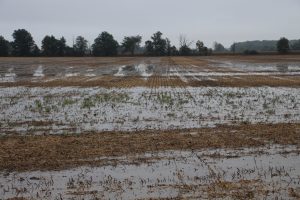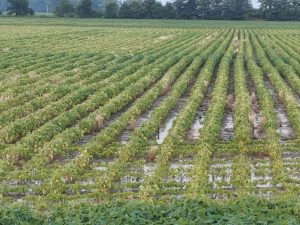Keeping Crops Healthy
By James Hoorman, Hoorman Soil Health Services
Depending upon when they were planted, crops are either emerging or starting to grow quickly. This time of year, million-dollar rains (rains around 1 inch) encourage crops to grow quickly. Soil microbes live in the water films around roots, using water to travel around and to process nutrients. After a nice rain, crops often have tremendous growth because plant available nutrients are being released. Unfortunately, either too much rain or not enough, greatly slows down plant nutrient acquisition.
Scouting corn, soybeans, and even vegetable crops; nutrient deficiencies are already starting to appear, although the signs are subtle. In corn, yellow striping on corn leaves is a sign of sulfur (S) deficiency and most soil test are showing that S is lacking. Sulfur is needed to make proteins like cysteine and methionine. Since the enforcement of the Clean Air Act (which was a free source of S), some fields may now need S fertilization. Sulfur is needed in a 10:1 nitrogen to sulfur ratio to maximize crop production. Sulfur is a part of many fertilizers, so it can easily be supplemented during the growing season.
Phosphorus (P) deficiency shows up as purple at the bottom of corn stalks and was quite noticeable in some field either this year. Some recent rains and warmer weather have lessened the purple coloring as soil microbes make P more available. Excess rain, soil compaction, and poor soil structure can make all nutrient deficiencies worse. Many of these nutrients need to be taken up in a reduced form, which often is soluble and leaches easily out of the soil profile. When soil compaction or poor soil structure exist, crop roots may not grow vigorously or even survive in saturated soils lacking oxygen.
Three other nutrients that may be lacking are Manganese (Mn), Iron Fe), and Zinc (Zn). The use of glyphosate (Roundup) tends to chelate or tie up these essential micro-nutrients. Oats can be planted as a cover crop to counter the negative effects of glyphosate. Manganese (Mn) and Iron (Fe) deficiency symptoms are often quite similar. On corn and soybeans, it shows up as yellow veins towards the leaf tip. All corn and soybeans should be a dark green to maximize photosynthesis. On strawberries, blackberries, and raspberries look for dark green veins with yellow green lef tissue between the veins. For zinc (Zn) deficiency, start looking for white mid-rib veins.
Already, signs of Zn, Mn, and Fe can be seen in corn and is even starting in soybeans. Iron is needed to make chlorophyll for photosynthesis.  Manganese is needed to split the water molecule to for plant growth, and Zn is a key element in 300 enzymes. Soil test on Fe and Mn are often confusing and misleading. Even though soil test may be high or even excessive, there are many forms, and the plant can only use one form. Manganese sulfate, zinc sulfate, and iron oxide can be supplemented, usually with fulvic acid to aid in getting micronutrients into plants.
Manganese is needed to split the water molecule to for plant growth, and Zn is a key element in 300 enzymes. Soil test on Fe and Mn are often confusing and misleading. Even though soil test may be high or even excessive, there are many forms, and the plant can only use one form. Manganese sulfate, zinc sulfate, and iron oxide can be supplemented, usually with fulvic acid to aid in getting micronutrients into plants.
Two other critical nutrients are boron (B) and calcium (Ca). Boron main purpose is to be the bus driver to get Ca into the plant. Calcium is a key element, activating 146 major enzymes needed for plant growth and yield. Boron deficiency shows up as parallel lines (like rail road tracks) on the edges of leaves. Calcium deficiency looks like leaf crinkling or even cupping in the center of the leaf. On potatoes and tomatoes, small deformed leaves or “mouse ears” is a sign of Ca deficiency. In soybeans, the signs are subtle, but small leaf crinkling or distortions around the leaf edges and the interior leaf are signs of B and Ca deficiencies. With adequate rain, gypsum (calcium sulfate) can be broadcast on fields at 200-400 pounds per acre. The Ca and S become available over about 30-40 days.
The majority of our crop nutrients are taken up at or after pollination in corn and soybeans. However, since corn yield is determined by V6 (six true leaves), nutrient deficiencies may be limiting future yields. The same logic probably applies to soybeans too. Keeping plants healthy and dark green maximizes photosynthesis and allows the plant to believe that it can produce a higher yield. Weather conditions and nutrient availability may limit yields later, but often early plant nutrition deficiencies put a lid on crop yields. If possible, limit glyphosate (Roundup) applications or plan to supplement with micro-nutrients (Fe, Mn, Zn, and copper). Healthy plants can out-compete most pests (weeds, insects, and diseases). Plants grown in high soil organic matter soils have more soil microbes and plant available nutrients for optimal healthy plant growth.
Depending upon when they were planted, crops are either emerging or starting to grow quickly. This time of year, million-dollar rains (rains around 1 inch) encourage crops to grow quickly. Soil microbes live in the water films around roots, using water to travel around and to process nutrients. After a nice rain, crops often have tremendous growth because plant available nutrients are being released. Unfortunately, either too much rain or not enough, greatly slows down plant nutrient acquisition.
Scouting corn, soybeans, and even vegetable crops; nutrient deficiencies are already starting to appear, although the signs are subtle. In corn, yellow striping on corn leaves is a sign of sulfur (S) deficiency and most soil test are showing that S is lacking. Sulfur is needed to make proteins like cysteine and methionine.
Since the enforcement of the Clean Air Act (which was a free source of S), some fields may now need S fertilization. Sulfur is needed in a 10:1 nitrogen to sulfur ratio to maximize crop production. Sulfur is a part of many fertilizers, so it can easily be supplemented during the growing season.
Phosphorus (P) deficiency shows up as purple at the bottom of corn stalks and was quite noticeable in some field either this year. Some recent rains and warmer weather have lessened the purple coloring as soil microbes make P more available. Excess rain, soil compaction, and poor soil structure can make all nutrient deficiencies worse. Many of these nutrients need to be taken up in a reduced form, which often is soluble and leaches easily out of the soil profile. When soil compaction or poor soil structure exist, crop roots may not grow vigorously or even survive in saturated soils lacking oxygen.
Three other nutrients that may be lacking are Manganese (Mn), Iron Fe), and Zinc (Zn). The use of glyphosate (Roundup) tends to chelate or tie up these essential micro-nutrients. Oats can be planted as a cover crop to counter the negative effects of glyphosate. Manganese (Mn) and Iron (Fe) deficiency symptoms are often quite similar. On corn and soybeans, it shows up as yellow veins towards the leaf tip. All corn and soybeans should be a dark green to maximize photosynthesis. On strawberries, blackberries, and raspberries look for dark green veins with yellow green lef tissue between the veins. For zinc (Zn) deficiency, start looking for white mid-rib veins.
Already, signs of Zn, Mn, and Fe can be seen in corn and is even starting in soybeans. Iron is needed to make chlorophyll for photosynthesis. Manganese is needed to split the water molecule to for plant growth, and Zn is a key element in 300 enzymes. Soil test on Fe and Mn are often confusing and misleading. Even though soil test may be high or even excessive, there are many forms, and the plant can only use one form. Manganese sulfate, zinc sulfate, and iron oxide can be supplemented, usually with fulvic acid to aid in getting micronutrients into plants.
Two other critical nutrients are boron (B) and calcium (Ca). Boron main purpose is to be the bus driver to get Ca into the plant. Calcium is a key element, activating 146 major enzymes needed for plant growth and yield. Boron deficiency shows up as parallel lines (like rail road tracks) on the edges of leaves. Calcium deficiency looks like leaf crinkling or even cupping in the center of the leaf. On potatoes and tomatoes, small deformed leaves or “mouse ears” is a sign of Ca deficiency. In soybeans, the signs are subtle, but small leaf crinkling or distortions around the leaf edges and the interior leaf are signs of B and Ca deficiencies. With adequate rain, gypsum (calcium sulfate) can be broadcast on fields at 200-400 pounds per acre. The Ca and S become available over about 30-40 days.
The majority of our crop nutrients are taken up at or after pollination in corn and soybeans. However, since corn yield is determined by V6 (six true leaves), nutrient deficiencies may be limiting future yields. The same logic probably applies to soybeans too. Keeping plants healthy and dark green maximizes photosynthesis and allows the plant to believe that it can produce a higher yield. Weather conditions and nutrient availability may limit yields later, but often early plant nutrition deficiencies put a lid on crop yields. If possible, limit glyphosate (Roundup) applications or plan to supplement with micro-nutrients (Fe, Mn, Zn, and copper). Healthy plants can out-compete most pests (weeds, insects, and diseases). Plants grown in high soil organic matter soils have more soil microbes and plant available nutrients for optimal healthy plant growth.
